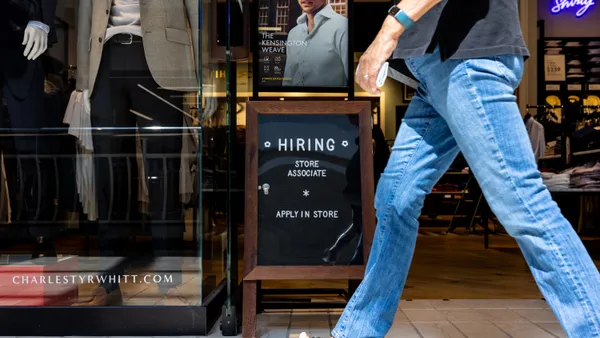Dive Brief:
- U.S. manufacturers have some 428,000 job openings and will need to fill more than 4 million positions in the next decade, Jay Timmons, president and CEO of the National Association of Manufacturers (NAM), said in an address Wednesday.
- That's despite the results of a survey released last December of 539 manufacturer respondents that showed 88.7% had a positive outlook on their company's future. In the same survey, however, 68.2% said an inability to attract and retain talent was their top concern, a finding that NAM said had held steady for five consecutive surveys.
- Previous NAM research, conducted in partnership with Deloitte and released November 2018, found common unfilled positions include those for skilled production workers, supply chain talent, engineers, scientists, software engineers and operational managers. That same research indicated such positions continue to go unfilled for a variety of reasons, including a negative perception of the manufacturing industry, a shift in desired skill sets thanks to the new technologies, and the retirement of baby boomers, according to respondents. Just days before Timmons' address, NAM released a report offering at least a partial solution to its woes: immigration reform that allows more high-skill workers into the country.
Dive Insight:
Employer lobbying groups and advocates are increasingly sounding the alarm on the skills gap — a perceived gap between the skill sets U.S. workers possess and the ones they will need to keep up with changing technologies, business models and other factors. Timmons' address comes just weeks after Johnny Taylor, president and CEO of the Society of Human Resources Management, the world's largest HR organization, called for a presidential mention of the problem in the latest State of the Union Address. President Donald Trump, however, didn't touch on the issue in his speech.
That's not to say the administration hasn't attempted to address the issue, however. Trump previously announced the creation of two advisory groups — a National Council for the American Worker and a workforce policy advisory board — as well as a "Pledge to America's Workers" to work with the private sector to create 6 million training opportunities. Experts have told HR Dive those efforts could go farther, however, particularly with respect to education reform.
There's also the issue of immigration reform. In last week's document, NAM called for investments in security and infrastructure "by adding walls, fencing, surveillance technology" and other measures, but also suggested the U.S. remove limits on high-skilled immigration and raise the cap for H-1B visas. The proposal was meant to use policy ideas from both Democrats and Republicans, Timmons said in the address. "It's a realistic compromise," he said. "That's what it's going to take and that's what Americans expect." Trump has said he is looking into the H-1B issue but has not yet adopted any concrete changes.
Meanwhile, other groups view the skills gap differently, saying employers are at least partially to blame. The Economic Policy Institute, a progressive think tank, published an analysis in July 2018 arguing that employers with "monopsony power" that want to increase hiring are not paying enough to attract workers. Others have instead refocused the discussion away from a lack of skills and toward the gap between the labor market's supply side and demand side.
Regardless, manufacturers have indicated they're attempting new approaches to the issue. According to a previous PwC and NAM survey, one such approach is to boost diversity and inclusion programming. Others are partnering with community colleges and similar institutions on job-specific training programs in communities. And still more are trying to deal with the industry's image problem through rebranding efforts.












